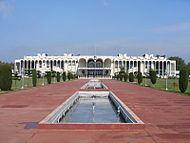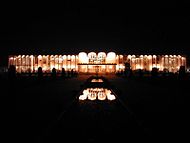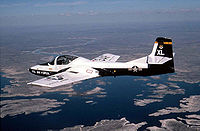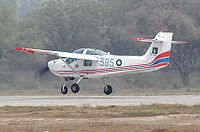- Pakistan Air Force Academy
-
"RAF Risalpur", "Risalpur Airbase/Airfield" & "Pakistan Air Force/PAF Base Risalpur" redirects here.
Pakistan Air Force Academy 
Motto فقط ذوق پروازهے زندگى (Urdu) Established 1910 as Royal Flying Corps of Risalpur
Renamed on 14 August 1947Type Military academy AOC AVM Syed Hasan Raza Admin. staff 300 Undergraduates 500 (approx.) Postgraduates 150 (approx.) Location Risalpur, Khyber-Pakhtunkhwa, Pakistan Nickname Home of Eagles Mascot Eagle PAF Academy Risalpur IATA: none – ICAO: OPRS Summary Airport type Military Operator PAF Location Risalpur, Pakistan Elevation AMSL 1,050 ft / 320 m Coordinates 34°04′52″N 071°58′21″E / 34.08111°N 71.9725°E Runways Direction Length Surface m ft 09R/27L 2,769 9,085 Asphalt 09L/27R 1,780 5,840 Asphalt Source: DAFIF[1] The Pakistan Air Force Academy also known as PAFA, is an accredited co-educational four-year college for the undergraduate education of officer candidates for the Pakistan Air Force. Its campus is located in the remote town Risalpur of Nowshera District in the Khyber-Pakhtunkhwa province of Pakistan,[2] is the premier cadet training institution of the Pakistan Air Force which offers academic professional degrees. Its role is the training of General Duty Pilots (GDP), Aeronautical and Avionics Engineers and the initial training of other Ground Branch cadets. Cadets of all the branches join the Academy following a recommendation by the Inter Services Selection Board (ISSB) of Pakistan. Graduates of the Academy's four-year program receive a Bachelor of Science degree, and most are commissioned as flying officers (lieutenants) in the Pakistan Air Force.
The Academy was created in 1910 and was a former aerodrome/airfield of the Royal Flying Corps then later Royal Air Force.[citation needed] It officially became the airbase of the PAF on 15 August 1947. On 21 January 1967, it was again upgraded to the status of an academy by then-President Ayub Khan. Currently, it consists of 5 different components.
At the heart of the PAF since its inception, the Pakistan Air Force Academy has bred generations of officers for the PAF and other branches of the Pakistani Armed Forces. The Academy now has impressive premises with state-of-the-art infrastructure portraying the progress from the modest beginning initiated by a handful of dedicated men in 1947.[3]
Contents
Location
Located in a basin some 1014 feet above sea level, it is bounded on the south and west by the Kabul and Kalpani rivers, respectively. It is situated eight kilometers from the city of Nowshera; the famous Khyber Pass lies 90 kilometers to the north.[2] The Risalpur cantonment itself lies on high ground, some 30 feet above the surrounding area, with the oldest building dating from 1913 or 1914.[4]
History
During the First World War, the Royal Flying Corps established a base at Risalpur. By 1940, Risalpur had become both a training and an operational base. During the Second World War, Risalpur became the main fighter conversion base.[4]
The airbase was formally established after the creation of Pakistan on 15 August 1947 with 20 officers, 21 trainees, 23 senior non commissioned officers (SNCOs) and 257 airmen. The base comprised only a handful of men and some equipment. One month later, the Flying Training School was established at Risalpur. Wing Commander Asghar Khan, later to become the first Air Chief of the PAF, took over as the first Officer Commanding of the School, with Harvard and Tiger Moth aircraft in the inventory. Flt Lt M Khyber Khan, who later rose to the rank of Air Vice Marshal, and his student, Flight Cadet Akhtar, flew the first training sortie on 22 September 1947.[5]
On 13 April 1948, the founder of Pakistan, Muhammad Ali Jinnah, visited Risalpur Flying Training School and raised its level to that of a college. Risalpur thus became the genesis of PAF pilots. It became the only Military Academy of Pakistan to be visited by Jinnah.[6][7] At this ceremony, Jinnah took the General Salute at the parade. Fighter aircraft from Peshawar Air base also performed aerobatics at the event.
On January 21, 1967 President Ayub Khan elevated the status of the PAF College, Risalpur to that of an academy.[8]
Aircraft
Initially, the institution was equipped with Harvard, Tiger Moth, Auster, Fury and Tempest aircraft. A major change came with the introduction of the T-37 jet trainer in May 1962. Eight years after the College was upgraded to an Academy in 1967, the T-6G (Harvard), which had rendered yeoman service to the PAF since 1947, was replaced by the Mushshak (Saab Trainer). Currently, the trainer aircraft at the PAF Academy comprise of T-37, Mushshak MFI-17 and the K-8, the last of which was brought into service with the PAF in 1995.
Constituent units
The PAF Academy consists of 5000 components:
College of Flying Training
Main article: College of Flying TrainingThe College of Flying Training aims to equip the cadets with basic flying skills and a sound academic foundation, leading eventually to the award of a BS in Aviation Sciences and Management from Air University Islamabad. It prepares the cadets for flying fighter aircraft in the next phase of their career. Academic Training at Directorate of Studies (DOS) consists of Aero Sciences, Aviation Sciences, Humanities, Airmanship and Airspace Management disciplines. The college also caters for the basic and professional training of the officers of various ground support branches.
College of Aeronautical Engineering
Main article: College of Aeronautical EngineeringThe College of Aeronautical Engineering (CAE) was established in July 1965 at Korangi Creek, Karachi, with Colonel John H. Blakelock, USAF, as its first principal. The role of the PAF Academy became all the more important when the College of Aeronautical Engineering was relocated after 22 years, from Karachi to Risalpur. Its relocation led to centralized officer training, and the promotion of comradeship in the PAF. Being part of the PAF Academy, the CAE has undergone tremendous advancement since 1988. In order to cope with modern technologies, its curriculum was upgraded, laboratories and workshops were improved and the latest computer facilities added. The role of the institution has also been progressively revised. In addition to training prospective and serving engineering officers of the PAF and the trainees of other organizations for their BE degree in Aerospace and Avionics, the CAE also conducts postgraduate programs and undertakes research and development in the relevant disciplines. It was affiliated with the National University of Sciences and Technology (NUST) in 1995.[9]
Flying Instructors School
The Flying Instructors School (FIS) trains instructors, not only for the PAF but also for the Pakistan Army and Navy. Due to its high standards, the FIS also has a good reputation outside of Pakistan. It currently trains instructors from countries in the Middle East, Southeast Asia, and Africa. The FIS is also responsible for the maintenance of high standards of teaching in the College of Flying Training, and the Fighter Conversion units. The re-categorization of instructors in all three armed forces is an additional responsibility of the School. The FIS follows a three-dimensional training system, which includes academic training, flying training, and instructional technique. The FIS also undertakes reciprocal visits to enhance training standards; between 1990 and 1997, these visits were organized with the Central Flying School, UK.
Para Training School
The Para Training School was established at the PAF Academy Risalpur in 2003. It is the second parachute school in Pakistan after the Pakistan Army Para School located at Peshawar. Before its establishment, PAF personnel were trained at the Pakistan Army Para School. The school conducts various basic and advanced courses, including free fall training.[10] It also trains cadets to fly para motor gliders.[11] The Special Service Wing of the PAF also receives parachute training at this school
Military Training Wing
The role of the Military Training Wing (formerly Cadet's Wing) is aimed to impart general service training and develop physical fitness, discipline, personal and leadership qualities in cadets. The subjects covered include[12]:
- Air Operations
- Use of Small Arms
- Fieldcraft (Camping-Visits etc.)
- Leadership
- Character Building
- Physical Exercises
- Military Drill
- Sports Activities
- The Cadets Mess
- Extra Curricular Activities
- Literary Activities
- Educational Visits
- Student Counseling
The Military Training Wing comprises officers and instructors who monitor the activities of cadets throughout their training period.[12] The Military Training Wing is sub-divided into four squadrons. The squadrons take part in various competitions and the overall winning squadron is awarded the "Quaid-e-Azam Banner" at the passing out ceremony which is held at the end of term.
The PAF Academy is entrusted with the responsibility of training, nurturing and grooming future officers of the PAF. It also has the privilege of training cadets and officers of the Pakistan Army, Navy, Pakistan International Airlines and other countries including Bangladesh, Brunei, China, Indonesia, Iran, Jordan, Malaysia, Nepal, Nigeria, Qatar, Saudi Arabia, Sri Lanka, Sudan, Syria, Turkey, Turkmenistan and the UAE.[13]
Events
Passing Out Parade
Passing Out ParadeThe Passing Out Parade is held every six months. The graduating cadets of flying and engineering pass out at this parade. The chief guests are usually the President, Prime Minister or the service chiefs of the armed forces of Pakistan. Graduating cadets take the Oath of Allegiance under the flag of Pakistan, after which they take the salute of the parade. The end of the parade is marked by the aerobatics display of the PAF Aerobatic team renowned as the "Sherdils" (flying T-37 aircraft) and the Academy Aerobatic team known as "Academy Hawks" (flying K-8 aircraft).[3][14] The awards presented to the cadets at this occasion are:[15]
- Chairman Joint Chiefs of Staff Committee's Trophy (for Best performance in General Service Training in CAE)
- Chairman Joint Chiefs of Staff Committee's Trophy (for Best performance in General Service Training in CFT)
- Chief of Air Staff's Trophy (for Best performance in Engineering Discipline)
- Chief of Air Staff's Trophy (for Best performance in Flying)
- Sword of Honor (for Best performance in CAE)
- Sword of Honor (for Best performance in CFT)
Convocation
This event also takes place after six months. Two convocations are held each time - one for graduating cadets of the GD(P) branch and the other for cadets of the engineering branch. The awards presented at this occasion are:[16]
GD(P) Course Convocation
- Best Performance Trophy (Air Science Subject)
- Best Performance Trophy (Ground Subjects)
- Best Performance Trophy (Humanities Subject)
Engineering Course Convocation
- President’s Gold Medal (Aerospace Engineering)
- Rector’s Gold Medal (Aerospace Engineering)
- Rector's Best Aerospace Vehicle Design Certificate (Aerospace Engineering)
- President’s Gold Medal (Avionics Engineering)
- Rector’s Gold Medal (Avionics Engineering)
- Rector's Best Avionics System Design Certificate (Avionics Engineering)
Graduation
The graduation ceremony of non-Ground Branches courses is held annually at the Academy. The cadets joining ground branches after completing their HSSC spend two years at the Academy whereas the Bachelor cadets course has a duration of one year.
Changing of the Guard at Mazare-e-Quaid
Another important event is the annual Changing of the Guard ceremony at Mazar-e-Quaid, Karachi on Pakistan Defence Day (September 6). Cadets from the PAF Academy assume guard duties at the mazar on this day.[7][17]
All Pakistan Bilingual Declamation Competition
The PAF Academy also holds an All-Pakistan Declamation Competition, one of the biggest annual events. Some forty teams from different major higher education institutes in Pakistan are invited to take part. The event takes place over four days during which a number of rounds are held. The PAF bears all the expenses of travel and accommodation of the teams.[18]
Falcons Hearth
The memorial of the academy is known as ‘Falcons Hearth’ and is situated on the parade ground. It was erected in memory of cadets and instructors martyred during training, and also those who lost their lives on active service during the Indo-Pakistani War of 1965 and the Indo-Pakistani War of 1971.
Gallery
- Aircraft at Risalpur
-
Muhammad Ali Jinnah being given a General Salute -
Muhammad Ali Jinnah being received at Risalpur
See also
References
- Notes
- ^ Airport information for OPRS at World Aero Data. Data current as of October 2006.Source: DAFIF.
- ^ a b Pakistan.Gov.pk - The Official Web Gateway to the Government of Pakistan
- ^ a b Shaheen Foundation, "The Story of Pakistan Air Force(1988-1998)".
- ^ a b Wg Cdr Zafar Iqbal(R), "True North", pp 47.
- ^ Syed Shabbir Hussain, "History of Pakistan Air Force (1947-1984)".
- ^ Pakistan Air Force - BREAKING THE BARRIERS
- ^ a b Pakistan Times | Top Story: Pakistan celebrates Defence Day in befitting manner
- ^ PAF Falcons - Today In History
- ^ National University of Sciences & Technology
- ^ Daily Times - Leading News Resource of Pakistan
- ^ PAF Academy holds commissioning ceremony
- ^ a b http://www.pakistan.gov.pk/ministries/defence-ministry/news/current/Training%20in%20Pakistan%20Air%20Force.doc
- ^ Pakistan Air Force Official Website
- ^ http://www.app.com.pk/en/index.php?option=com_content&task=view&id=20713&Itemid=2
- ^ Graduation parade held at PAF -DAWN - National; October 28, 2001
- ^ NOWSHERA: PAF cadets awarded degrees -DAWN - Local; December 29, 2002
- ^ Shaheen Foundation, "The Story of Pakistan Air Force(1988-1998)",pp 128.
- ^ Shaheen Foundation, "The Story of Pakistan Air Force(1988-1998)", pp 179.
External links
List of Pakistan Air Force BasesFlying Bases 
Non-Flying Bases Africa Egypt · South AfricaThe Americas Asia Europe Oceania AustraliaCategories:- Pakistan Air Force bases
- Air force academies
- Airports in Pakistan
- Pakistan Air Force
- Military academies of Pakistan
- Military installations of Pakistan
- Universities and colleges in Nowshera District
Wikimedia Foundation. 2010.







